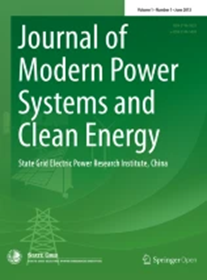An Analytical Method for Delineating Feasible Region for PV Integration Capacities in Net-zero Distribution Systems Considering Battery Energy Storage System Flexibility
IF 5.7
1区 工程技术
Q1 ENGINEERING, ELECTRICAL & ELECTRONIC
Journal of Modern Power Systems and Clean Energy
Pub Date : 2024-02-26
DOI:10.35833/MPCE.2023.000633
引用次数: 0
Abstract
To provide guidance for photovoltaic (PV) system integration in net-zero distribution systems (DSs), this paper proposes an analytical method for delineating the feasible region for PV integration capacities (PVICs), where the impact of battery energy storage system (BESS) flexibility is considered. First, we introduce distributionally robust chance constraints on network security and energy/carbon net-zero requirements, which form the upper and lower bounds of the feasible region. Then, the formulation and solution of the feasible region is proposed. The resulting analytical expression is a set of linear inequalities, illustrating that the feasible region is a polyhedron in a high-dimensional space. A procedure is designed to verify and adjust the feasible region, ensuring that it satisfies network loss constraints under alternating current (AC) power flow. Case studies on the 4-bus system, the IEEE 33-bus system, and the IEEE 123-bus system verify the effectiveness of the proposed method. It is demonstrated that the proposed method fully captures the spatio-temporal coupling relationship among PVs, loads, and BESSs, while also quantifying the impact of this relationship on the boundaries of the feasible region.考虑电池储能系统灵活性的净零配电系统中光伏集成能力可行区域划分分析方法
为了给零净配电系统(DSs)中的光伏(PV)系统集成提供指导,本文提出了一种分析方法,用于划分光伏集成容量(PVIC)的可行区域,其中考虑了电池储能系统(BESS)灵活性的影响。首先,我们引入了关于网络安全和能源/碳净零要求的分布稳健机会约束,这些约束构成了可行区域的上界和下界。然后,提出可行区域的表述和解决方案。由此得到的分析表达式是一组线性不等式,说明可行区域是高维空间中的一个多面体。设计了一个程序来验证和调整可行区域,确保其满足交流电流下的网络损耗约束。对 4 总线系统、IEEE 33 总线系统和 IEEE 123 总线系统的案例研究验证了所提方法的有效性。研究表明,所提出的方法完全捕捉到了光伏、负载和 BESS 之间的时空耦合关系,同时还量化了这种关系对可行区域边界的影响。
本文章由计算机程序翻译,如有差异,请以英文原文为准。
求助全文
约1分钟内获得全文
求助全文
来源期刊

Journal of Modern Power Systems and Clean Energy
ENGINEERING, ELECTRICAL & ELECTRONIC-
CiteScore
12.30
自引率
14.30%
发文量
97
审稿时长
13 weeks
期刊介绍:
Journal of Modern Power Systems and Clean Energy (MPCE), commencing from June, 2013, is a newly established, peer-reviewed and quarterly published journal in English. It is the first international power engineering journal originated in mainland China. MPCE publishes original papers, short letters and review articles in the field of modern power systems with focus on smart grid technology and renewable energy integration, etc.
 求助内容:
求助内容: 应助结果提醒方式:
应助结果提醒方式:


